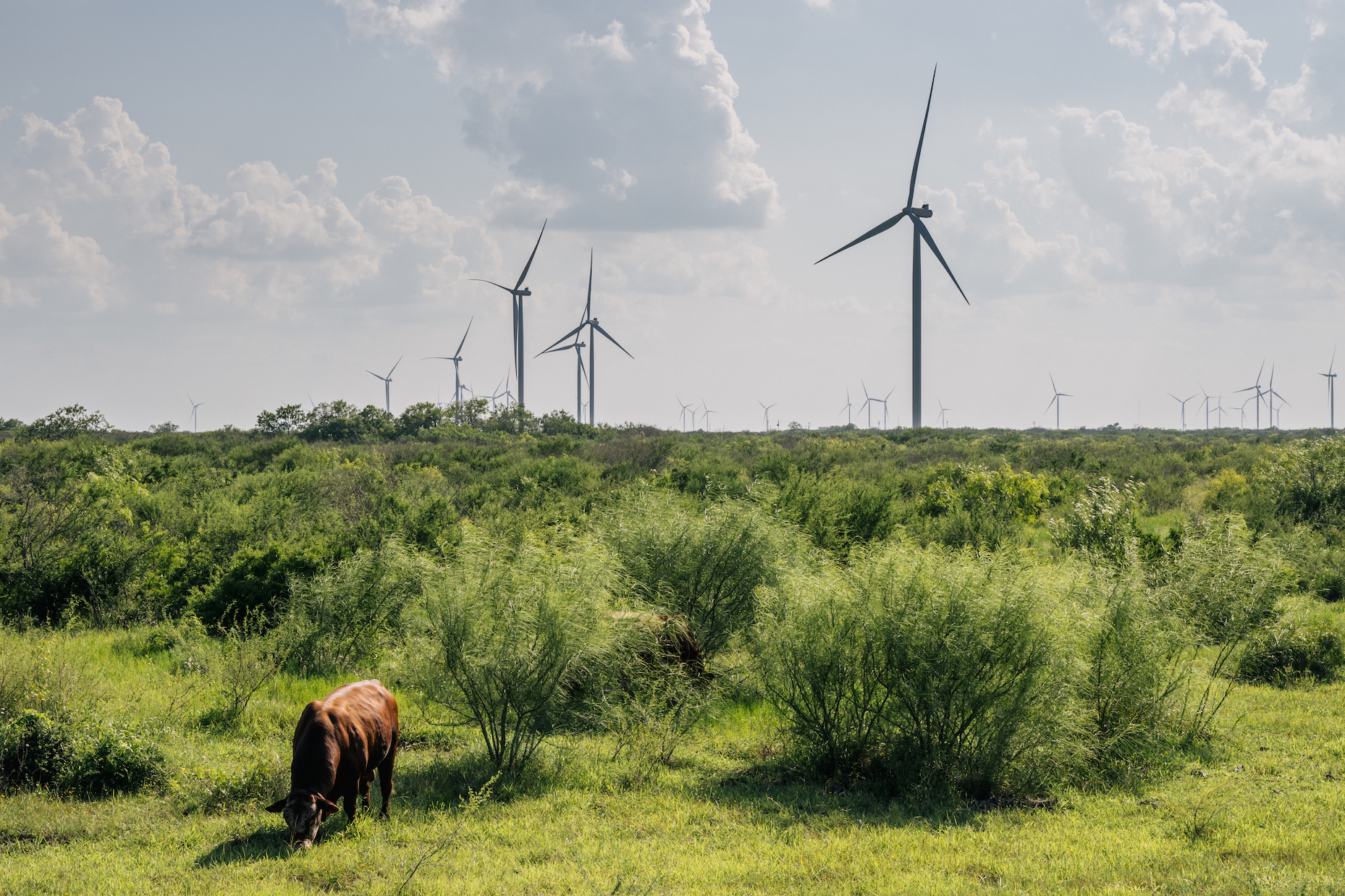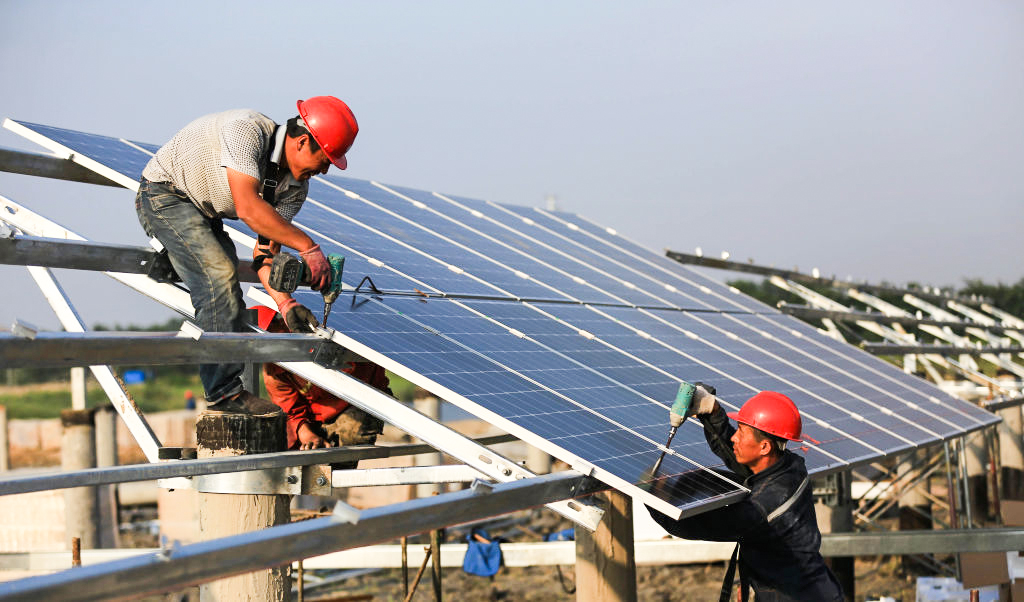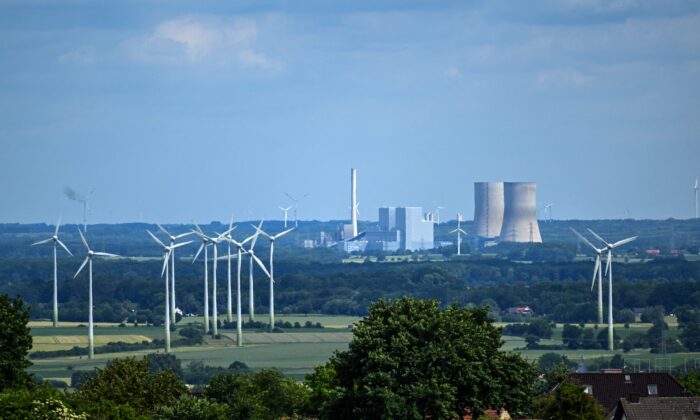By Kevin Stocklin
News Analysis
American Founding Father Benjamin Franklin once said that “experience is an expensive school but fools will learn in no other.” Germany’s green energy policy, launched in the year 2000, could have been a cheap lesson for America today.
The Biden administration has chosen to follow Germany, providing heavy subsidies for wind and solar, while suppressing industries that could reliably meet America’s energy needs and even reduce its carbon footprint. In January, the administration announced that it had “pulled every lever to position America to scale up clean energy … the Biden-Harris Administration has readied offshore areas to harness power from wind, approved new solar projects on public lands, and passed the Bipartisan Infrastructure Law to build thousands of miles of transmission lines that deliver clean energy.”
On June 6, the Biden Administration invoked the Defense Production Act to increase the production of green energy and to replace the use of fossil fuels. While the legality of this move is questionable, it established the U.S. government as a major controlling party in America’s heretofore private energy industry. But like most grand government adventures into industrial policy, the push for renewables is already revealing itself to be enormously wasteful and counterproductive.
Twenty-two years ago, Germany stepped into the forefront of the green energy movement, implementing its “Energiewende,” an ambitious program of subsidies for solar panels and wind turbines, coupled with a reduction in coal, oil, and natural gas. After the 2011 nuclear disaster in Fukushima, Japan, Germany decided to also close its nuclear plants.
In 2000, less than 7 percent of Germany’s electricity came from so-called renewables. By 2021, that share exceeded 40 percent of the country’s electricity generation and about 20 percent of its total energy consumption, including electric vehicles (EVs).
By the end of 2021, before the Ukraine war drove prices even higher, German households paid 32 cents per kilowatt-hour for electricity. The rate in France, which kept its nuclear industry intact, was 23 cents. Americans paid an average price of 11 cents for electricity at that time—about a third of what Germans paid. Twenty percent of Germans’ electric bills went to a “renewables surcharge” to subsidize wind and solar.
Germany had spent heavily to increase its renewable energy capacity, but in the case of wind and solar, capacity never delivered the promised output. According to a 2020 report from the Institute for Electrical and Electronics Engineers (IEEE), Germany’s electricity output in 2000 was 54 percent of its total capacity, also known as the “capacity factor.” Unused capacity is the norm for power grids because the demand for electricity varies significantly depending on the time of day, the season, and the weather. By 2019, however, while Germany’s total electricity capacity had risen dramatically thanks to a sharp increase in renewables, its capacity factor had fallen to just 20 percent, largely because wind and solar generators were less productive than fossil fuels or nuclear.
The capacity factor for solar energy was just 10 percent because much of the country is often overcast. Wind energy was also producing well below capacity because wind turbines produced no energy on calm days and had to shut down on particularly gusty days to prevent turbine blades from being damaged. Even within those limits, the amount of energy produced by wind turbines was hugely variable depending on how hard the wind was blowing.
“It costs Germany a great deal to maintain such an excess of installed power,” the IEEE report stated. “The average cost of electricity for German households has doubled since 2000.”
A major problem with wind and solar is not only that they are unreliable, but also that they tend to generate the most power when people need it least. The peak seasons for wind generation tend to be fall and spring, but the peak demand for energy occurs in summer and winter when people need to heat or cool homes and offices.
An electricity grid must manage huge variability in demand. It must have enough capacity to cover peak demand, for example during the hottest hours of summer, but also have the flexibility to reduce power during early morning hours or springtime days when demand falls considerably. Because renewables are unpredictable in terms of how much energy they will produce, and when, they add substantial variability to the supply side of the equation as well.

“The whole idea that you would take something as complicated as an electric system, one of the most complicated things people have invented to date, and choose what to put on that system and how to run it by a popularity contest, to me that’s nuts and it’s going to end in tears,” Peter Hartley, Professor of Energy Economics at Rice University, told The Epoch Times. “Trying to run that system with politics is not a very smart thing to do.”
Germany’s energy sector had a difficult year in 2021 because the winds were calm. Even as demand surged, wind output fell by a quarter in 2021. The capacity factor for solar also fell because it was not a particularly sunny year.
After a sharp drop in 2020 due to the COVID-19 pandemic, Germany’s CO2 emissions increased by 31 million tons in 2021. A significant portion of this increase was due to the failure of renewables to produce, which forced Germany to lean more heavily on fossil fuels, including coal, to keep its electric grid going. And while shutting down its own nuclear plants, Germany also bought nuclear-generated electricity from France.
The surplus periods for wind and solar brought problems as well. When the weather cooperates and wind and solar produce at peak capacity, they often generate more power than consumers want. This leaves power companies with the choice of either trying to store excess energy, which is technologically problematic, or trying to offload it at deep discounts. This left Germany in a position of importing energy when prices were high and attempting to dump excess energy on a saturated market when prices were low.
The same thing happens in the United States. In Texas, for example, wind farms have been known to even pay grid operators to take their excess output. America’s wind farms receive government subsidies based on the amount of power they sell to utilities. This means that they can pay grid operators to take their excess energy and still make a profit as long as the amount they pay is less than what the government pays them in subsidies.
This market distortion from government intervention comes at a price, however. In America, traditional energy producers that don’t get subsidies, such as natural gas, struggle to make a profit when prices are artificially depressed, and this means that more reliable energy producers are crowded out of the market and, in many cases, are shut down. Nuclear energy, a reliable, relatively inexpensive, carbon-free producer, suffers the most because of how costly it is to cycle nuclear plants up and down.
“By having governments force intermittent renewables into the system through industrial policy,” Hartley said, “You’re actually penalizing nuclear, which might be the best long-run solution.”
There is an ongoing debate about how much and how fast CO2 emissions are changing the earth’s climate. However, if reducing carbon emissions is the ultimate goal, nuclear is probably the best means of achieving it. It emits far less CO2 than renewable energies, when mining and construction are taken into account; it is scalable; it is steady, reliable, and not subject to wild variations due to the weather; and it builds energy independence.
“Two of the most successful mass displacement of fossil fuels in the world are the nuclear programs in France and Sweden,” Hartley said. Nuclear is by far the most energy-dense technology, producing 10,000 times the amount of energy per kilogram that diesel fuel produces. It also takes up less space than solar panels and requires far less mining, with all the collateral damage that comes with that.
The downsides of nuclear are well known: nuclear waste and the possibility of catastrophic accidents such as Chernobyl, Three Mile Island, and Fukushima. However, new innovations in nuclear energy have made the technology safer, cleaner, more flexible, and more scalable. Downsized nuclear plants called Small Modular Reactors can be built closer to industrial users, reducing the cost of building lengthy transmission networks.
While Germany appears to have closed the door on nuclear energy, the European Union is reportedly drawing up plans to reclassify natural gas and nuclear energy as “green.”
According to Jessica Johnson, communications director for Nucleareurope, “We’re starting to see member states recognize that in order to have a stable supply of low carbon electricity, nuclear needs to be part of the mix.”
Europe has set ambitious targets to “decarbonize our economy completely by 2050,” Johnson said. If nuclear energy is excluded, “we can forget those targets.”
Currently, about 25 percent of Europe’s electricity is generated by nuclear power, as well as half of Europe’s “low-carbon” electricity. Belgium is rethinking its program to phase out its nuclear plants, Johnson said. France has proposed ambitious plans for building up to six new nuclear plants, and “a couple of weeks ago, in a manifesto, the Finnish Green Party made a clear statement in support of nuclear.”
‘Carbon Debt’
Germany’s Energiewende has succeeded in reducing its national carbon footprint substantially, but it only measures emissions within its own borders. Had it measured its actual global footprint, it would have discovered that the batteries, solar panels, and EVs that it was importing were increasing CO2 emissions substantially.
EVs come with a “carbon debt.” This refers to the fact that manufacturing electric batteries, an industry projected to grow to $100 billion by 2025, is highly pollutive. A 2018 report by the International Council on Clean Transportation, a green energy advocate, noted that the production of EV batteries in China, where more than half of the world’s lithium-ion batteries are made, generated 60 percent more CO2 than building traditional gasoline-powered engines.
A report by the World Economic Forum, another renewables advocate, stated that the amount of fossil fuel required to build EVs exceeds that for gas-fired cars to such an extent that “in Germany, a mid-sized electric car must be driven for 125,000 km, on average, to break even with a diesel car [in terms of CO2 emissions], and 60,000 km compared to a petrol car. It takes nine years for an electric car to be greener than a diesel car.” EV batteries last between 10 and 20 years.
Rare earth minerals essential to the production of solar panels, wind turbines, and EV batteries include lithium, nickel, cobalt, manganese, and graphite, among others. Copper is also essential for building extended power lines to connect grids to distant renewable sources, such as offshore wind farms and remote solar fields.
According to a report by the International Energy Agency (IEA), in order to meet the climate goals of the Paris Agreement, the production of these minerals would have to increase by six times over what it is today, by 2040. Furthermore, “The production of many energy transition materials is more concentrated than that of oil or natural gas … the world’s top three producing nations control over three-quarters of global output.”
The dominant players in this market are the Democratic Republic of the Congo (DRC) and China, which together control a majority of the production of many essential renewable-energy minerals. “China’s share of refining is around 35% for nickel, 50-70% for lithium and cobalt, and nearly 90% for rare earth elements,” the report states.
The mining of these materials is energy-intensive and can be devastating to local environments. Lithium, for example, comprises only about one percent of the rock from which it is mined, causing the destruction of large swathes of land in the mining process in order to extract it. Lithium and copper mining also require huge amounts of water, straining natural resources. Cobalt is often mined by child slave labor in Africa. And the refining process releases toxic heavy metals and other pollutants into the soil and water.
The installation of solar panels requires taking large plots of land and displacing wildlife. Wind turbines kill birds and bats. And the disposal of these often toxic minerals, once batteries, turbines, and solar panels reach the end of their productive use, has yet to be resolved.
‘Conditions of Genocide’
Germany struggled with the moral consequences of its Energiewende. The German parliament determined that the solar panels it was buying from China were being manufactured under “conditions of genocide” and slave labor.
“People think they’re very virtuous with these wind, solar, electric vehicles and so forth,” Hartley said. “But when you look into the background of these things, it’s pretty dicey stuff from a human rights point of view, let alone the strategic issues.”

In February, these strategic issues came to the fore when Russia invaded Ukraine, and Germany discovered how dependent it had become on unfriendly foreign suppliers. Wind and solar, upon which it had bet so heavily, proved incapable of filling the gaps its energy policies had created, and the embargo of Russian exports, together with counter-threats from Russia to cut off vital energy supplies to the West, hit Germany hard.
In May, Germany’s producer prices jumped 33.6 percent in annualized terms, the largest increase since data collection began in 1949, largely due to escalating energy costs. Energy prices shot up 87.3 percent from a year earlier; natural gas prices were up 154.8 percent.
A German federal audit in March warned of energy shortages and blackouts across Germany and power rationing between consumers and industry. With the sharp increase in the cost of inputs, the report said “there is a risk of losing Germany’s competitiveness and acceptance of the energy transition.” Last week, Germany raised its gas risk level to “alarm,” the second-highest level before “emergency.”
The German government could soon be in a position of choosing which companies are more essential than others when allocating scarce energy supplies. As is often the case with government industrial policies, the Energiewende could end up harming the industry to such an extent that the only solution would be more government intervention to save it.
Throughout Europe, some companies began shutting down in June, unable to compete with foreign firms whose energy costs were much lower. One country that is not transitioning to renewables is China.
A June Foreign Policy report stated that, while China is rapidly building out its battery manufacturing industry for export, “the country continues doubling down on coal” for its domestic energy. China expanded its coal mining operations by 300 million metric tons in 2022, “almost the annual production of the entire European Union.” The report notes that China is prioritizing energy stability and cost competitiveness, while “China’s main competitor, the United States, now experiences increasingly frequent supply disruptions as it works to transition its electric system, the world’s second largest, toward renewable energy.”
The strategic risks of Biden’s green gamble go beyond consumers and industry to include our military. Access to energy often proves to be decisive in military conflicts. One of the reasons that Germany and Japan were defeated in the Second World War was their inability to acquire fuel for their ships, planes, and tanks. Today, while America’s submarines and aircraft carriers are nuclear powered, most of our military still runs on oil derivatives; diesel for tanks and ships and jet fuel for aircraft.
China is not a significant producer of oil, which has been its strategic Achilles heel. Transitioning from fossil fuels to wind and solar, however, reverses this equation, making American industry dependent on China for the raw materials of renewable energy, when we have fossil fuels in abundance.
The lesson that the Biden administration could have learned from Germany is that wind and solar are inferior technologies that are inefficient, unreliable, polluting, and create a dangerous dependence on foreign countries that are not always your friends. Apparently, they weren’t paying attention.

